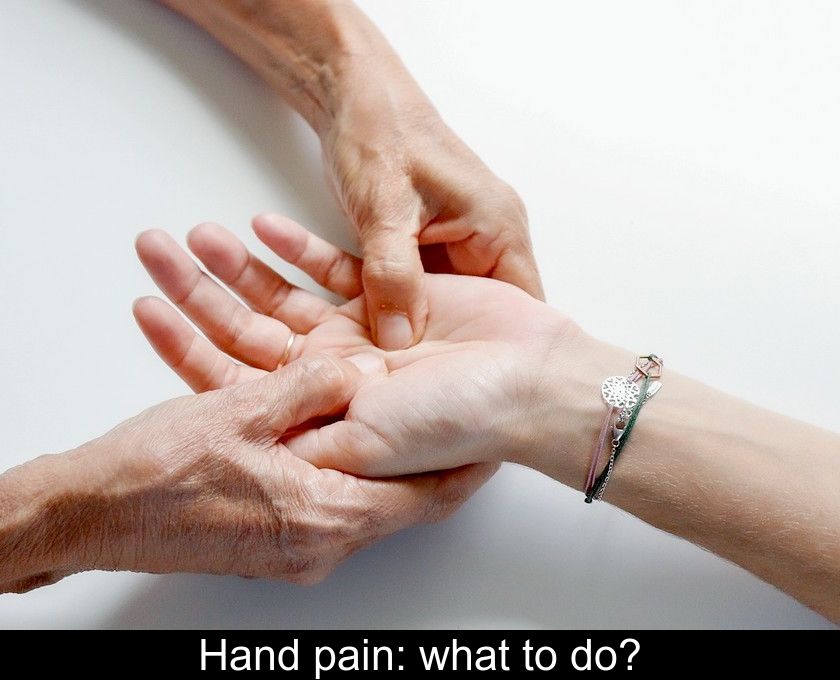Hand Pain: What To Do?
Highly solicited on a daily basis, our hands are particularly exposed to injuries and the wear and tear of time. This part of the body is also vulnerable, as each hand consists of tendons, nerves, and no less than 27 small bones. From carpal tunnel syndrome to osteoarthritis of the hands, including De Quervain's tendinitis, hand pain can have various causes. We will explain which diseases cause these pains, how to recognize the symptoms, and above all how to relieve a painful hand.
1- Carpal tunnel syndrome
Possible first origin of hand pain, carpal tunnel syndrome is characterized by nocturnal tingling in the thumb, index and middle fingers.
This pathology, common in women over 50, is linked to compression of the median nerve that passes at the base of the wrist. It is the most common musculoskeletal disorder or MSD in France (in 38% of cases).
Carpal tunnel syndrome may also have symptoms such as:
- A burning sensation that rises in the forearm
- Loss of sensitivity at the fingertips
- Loss of strength in the hands and some clumsiness.
During diagnosis, doctors evaluate the involvement of the median nerve through an examination called electromyogram.
This examination allows for treatment to be adapted according to the severity of the pathology. Stopping the gestures that cause compression and wearing a brace at night may be enough to relieve pain. If it persists, corticosteroid injections may be considered.
When the fingertips become numb and the examination confirms nerve damage, surgery is necessary to release the nerve and tendons, which provides rapid relief. The intervention is generally scheduled within a short period of time to preserve the nerve.
2- Osteoarthritis of the hands
A hand pain can also originate from osteoarthritis, especially if you have pain in your hands and fingers at night. The symptoms of hand osteoarthritis include sharp pain when moving the fingers, especially during the night and progressing through inflammatory outbreaks.
As with other locations in the body, hand osteoarthritis is caused by cartilage wear and tear. In the hands, it is the joints located at the base of the thumb that are most often affected by this problem. In this case, it is called rhizarthrosis and the pain, which manifests itself at the base of the thumb, can be mistaken for a wrist problem.
To relieve this significant discomfort, your doctor may prescribe oral anti-inflammatories during crises. Another more natural solution, green clay poultices can also provide relief during osteoarthritis outbreaks. Corticosteroid or hyaluronic acid injections are sometimes recommended as they provide patients with longer-lasting relief.
However, when the pain persists over the long term, surgical intervention must be considered to remove the trapezium bone or to place a mini-prosthesis. This second solution allows for faster restoration of thumb use.
Caution: do not confuse hand osteoarthritis with locked fingers. If you wake up with your fingers flexed and locked (usually at the level of the middle and ring fingers), this is not related to cartilage wear and tear but rather to thickening of the flexor tendon. In this case, it is called a trigger finger. Corticosteroid injections can help relieve this blockage, but in some cases, surgical intervention is necessary.
3- Quervain's tendinitis
It is quite common for hand pain to manifest at the back of the thumb because this finger is constantly used to "pinch" and grab objects. This repetitive motion eventually inflames the tendons that connect the thumb to the base of the wrist: this is the infamous De Quervain's tendinitis!
This painful condition often affects people who work in professions that require a lot of manipulation. Once again, it is a hand pain related to the exercise of a profession. To remedy this, the first solution is to rest the hand. If the problem persists, corticosteroid injections should be considered.
If there is no improvement, your doctor will prescribe an ultrasound to look for any anomalies such as supernumerary tendons or a multi-compartment tunnel, both of which require surgical intervention. Surgery is a last resort that should only be considered after other treatments have failed and when your hand problem becomes too debilitating.





